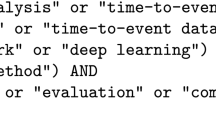Abstract
Linear regression analysis has been studied extensively in a random censorship setting, but typically all of the censoring indicators are assumed to be observed. In this paper, we develop synthetic data methods for estimating regression parameters in a linear model when some censoring indicators are missing. We define estimators based on regression calibration, imputation, and inverse probability weighting techniques, and we prove all three estimators are asymptotically normal. The finite-sample performance of each estimator is evaluated via simulation. We illustrate our methods by assessing the effects of sex and age on the time to non-ambulatory progression for patients in a brain cancer clinical trial.
Similar content being viewed by others
References
Albert A, Anderson JA (1984) On the existence of maximum likelihood estimates in logistic regression models. Biometrika 71: 1–10
Buckley J, James I (1979) Linear regression with censored data. Biometrika 66: 429–436
Cox DR (1972) Regression models and life tables (with discussion). J R Stat Soc B 34: 187–220
Dewanji A (1992) A note on a test for competing risks with missing failure type. Biometrika 79: 855–857
Dikta G (1998) On semiparametric random censorship models. J Stat Plan Inference 66: 253–279
Dinse GE (1982) Nonparametric estimation for partially-complete time and type of failure data. Biometrics 38: 417–431
Gao G, Tsiatis AA (2005) Semiparametric estimators for the regression coefficients in the linear transformation competing risks model with missing cause of failure. Biometrika 92: 875–891
Goetghebeur EJ, Ryan L (1990) A modified logrank test for competing risks with missing failure type. Biometrika 77: 207–211
Goetghebeur EJ, Ryan L (1995) Analysis of competing risks survival data when some failure types are missing. Biometrika 82: 821–833
Hahn J (1998) On the role of the propensity score in efficient semiparametric estimation of average treatment effects. Econometrica 66: 315–331
Hirano K, Imbens GW, Ridder G (2003) Efficient estimation of average treatment effects using the estimated propensity score. Econometrica 71: 1161–1189
Horvitz DG, Thompson DJ (1952) A generalization of sampling without replacement from a finite universe. J Am Stat Assoc 47: 663–685
Jin Z, Lin DY, Wei LJ, Ying Z (2003) Rank-based inference for the accelerated failure time model. Biometrika 90: 341–353
Koul H, Susarla V, van Ryzin J (1981) Regression analysis with randomly right-censored data. Ann Stat 9: 1276–1288
Lai TL, Ying Z (1991) Rank regression methods for left-truncated and right-censored data. Ann Stat 19: 531–556
Leurgans S (1987) Linear models, random censoring and synthetic data. Biometrika 74: 301–309
Li G, Wang QH (2003) Empirical likelihood regression analysis for right censored data. Stat Sinica 13: 51–68
Lo S-H (1991) Estimating a survival function with incomplete cause-of-death data. J Multivar Anal 39: 217–235
Lu W, Liang Y (2008) Analysis of competing risks data with missing cause of failure under additive hazards model. Stat Sinica 18: 219–234
Lu K, Tsiatis AA (2001) Multiple imputation methods for estimating regression coefficients in the competing risks model with missing cause of failure. Biometrics 57: 1191–1197
Lunceford JK, Davidian M (2004) Stratification and weighting via the propensity score in estimation of causal treatment effects: a comparative study. Stat Med 23: 2937–2960
McKeague IW, Subramanian S (1998) Product-limit estimators and Cox regression with missing censoring information. Scand J Stat 25: 589–601
Miller RG (1976) Least squares regression with censored data. Biometrika 63: 449–464
Peddada SD, Patwardhan G (1992) Jackknife variance estimators in linear models. Biometrika 79: 654–657
Reid N (1994) A conversation with Sir David Cox. Stat Sci 9: 439–455
Ritov Y (1990) Estimation in a linear regression model with censored data. Ann Stat 18: 303–328
Robins JM, Rotnitzky A, Zhao LP (1994) Estimation of regression coefficients when some regressors are not always observed. J Am Stat Assoc 89: 846–866
Santner TJ, Duffy DE (1986) A note on A. Albert and J. A. Anderson’s conditions for the existence of maximum likelihood estimates in logistic regression models. Biometrika 73: 755–758
Scharfstein DO, Rotnitzky A, Robins JM (1999) Adjusting for nonignorable drop-out using semiparametric nonresponse models (with discussion). J Am Stat Assoc 94: 1096–1146
Subramanian S (2004) Asymptotically efficient estimation of a survival function in the missing censoring indicator model. Nonparametr Stat 16: 797–817
Subramanian S (2006) Survival analysis for the missing censoring indicator model using kernel density estimation techniques. Stat Methodol 3: 125–136
Tsiatis AA (1990) Estimating regression parameters using linear rank tests for censored data. Ann Stat 18: 354–372
Tsiatis AA, Davidian M, McNeney B (2002) Multiple imputation methods for testing treatment differences in survival distributions with missing cause of failure. Biometrika 89: 238–244
Wang QH, Ng K (2008) Asymptotically efficient product-limit estimators with censoring indicators missing at random. Stat Sinica 18: 749–768
Wang QH, Linton O, Härdle W (2004) Semiparametric regression analysis with missing response at random. J Am Stat Assoc 99: 334–345
Ying Z (1993) A large sample study of rank estimation for censored regression data. Ann Stat 21: 76–99
Zhou X, Sun L (2003) Additive hazards regression with missing censoring information. Stat Sinica 13: 1237–1257
Author information
Authors and Affiliations
Corresponding author
Rights and permissions
About this article
Cite this article
Wang, Q., Dinse, G.E. Linear regression analysis of survival data with missing censoring indicators. Lifetime Data Anal 17, 256–279 (2011). https://doi.org/10.1007/s10985-010-9175-8
Received:
Accepted:
Published:
Issue Date:
DOI: https://doi.org/10.1007/s10985-010-9175-8




